The device of attic floors: selection and installation of insulation
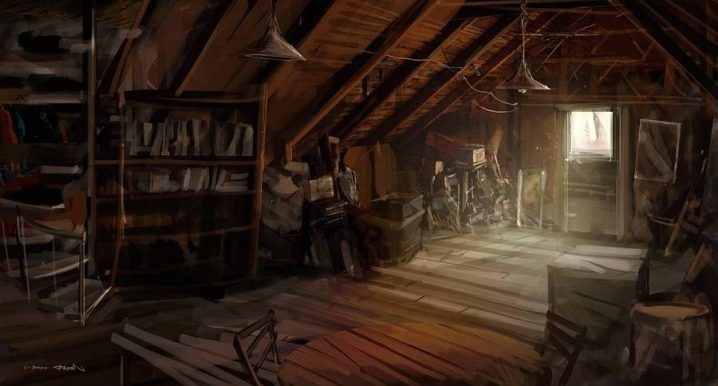
An attic is a dark or semi-dark space that serves to store unnecessary things and is visited only occasionally. But so that such a part of the house does not cause inconvenience, it is imperative to make the attic floors as reliable as possible - they must be both mechanically strong and guaranteed to keep warm.
What it is?
Traditionally, the attic is considered the technical area that completes the structure, because only the roof and roof, which are external structures, are located above it. In this part of the house, it is extremely rare to have living quarters, because it is usually used for life support systems and communal infrastructure. But since the temperature in the residential and technical area of the building cannot differ by more than 4 degrees, it is imperative to insulate this space.
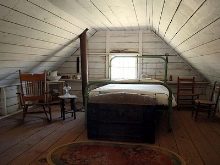
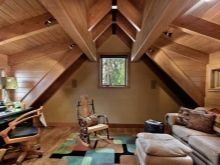

Peculiarities
The attic, allowing you to expand the developed space at the expense of the attic, is still being built for a rather long time and expensive. Construction requires a lot of effort, in addition, you need to thoroughly know the method of work and it is advisable to study at least one example of such an arrangement. It is much easier to simply insulate the upper part of the home - this will also save money.
Overlapping over wooden beams is most often done in the form of a pie, which includes:
- roll or boardwalk;
- a layer that stops the propagation of steam;
- ventilation gap;
- insulation material;
- additional vapor barrier;
- floor, and sometimes flooring if the attic is frequently visited.
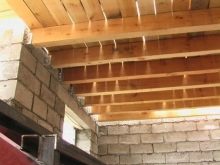

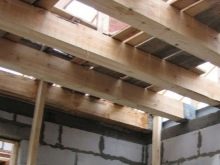
Even in a cold attic, a dormer is a useful element. Such structures can have a triangular configuration or be made in the form of an oval. Usually they are placed at a height of about a meter from the floor, equipped with grilles and blinds. The installation of a ceiling that compensates for heat losses through this window should be done only after the installation of the supporting structures has been completed.
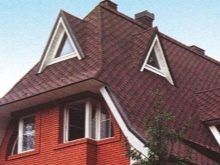
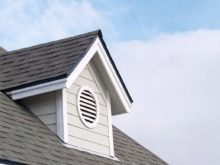
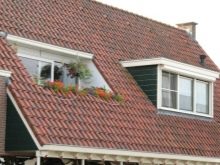
Floor options
In most cases, the attic floor is made of wooden beams.
The characteristic features of this option are:
- Limited overlap length. The span from one support to the other should be a maximum of 450 cm.
- Lightness of construction, which ensures minimum load on the walls and, accordingly, on the foundation.
- Convenient installation.
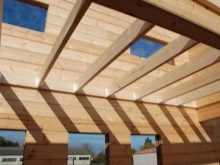
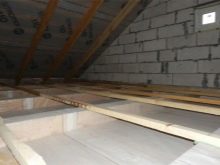

- The availability of timber structures compared to other materials.
- High speed of preparation, as well as the ability to complete all the work in one day, even without the use of lifting mechanisms.
- Compatibility with any sound insulation options.
It is necessary to immediately calculate the optimal cross-section of the beam, which must correspond to the load on it, and it is also worth taking into account the climate and thermal characteristics of the room.

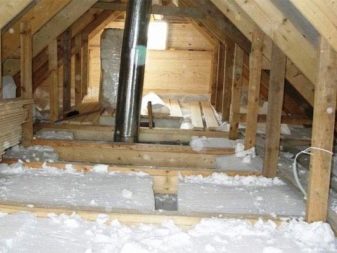
Materials (edit)
Regardless of the design chosen, it is preferable to use coniferous wood for the main unit, which is most resistant to high humidity, fungus and rotting. Sufficient thermal insulation is provided by beams with dimensions of 15x20 cm, but thinner ones (5x10 cm) are completely impractical. In the interval between the rolls, layers of waterproofing, vapor barrier and insulation are placed. It is better to attach not boards to the supports, but plywood with a thickness of 1.5-2 cm.
To secure the lower flooring, wooden blocks 5x5 cm are stuffed, the protrusion from which allows you to place boards or sheets.The roll is attached to the bars with self-tapping screws. A variety of materials can be used for the thermal insulation itself in a brick building. When the beam is inserted into the wall, it is poured with cement mortar (if the thickness of the masonry is two bricks) or left free if the wall is lined with 2.5 bricks.
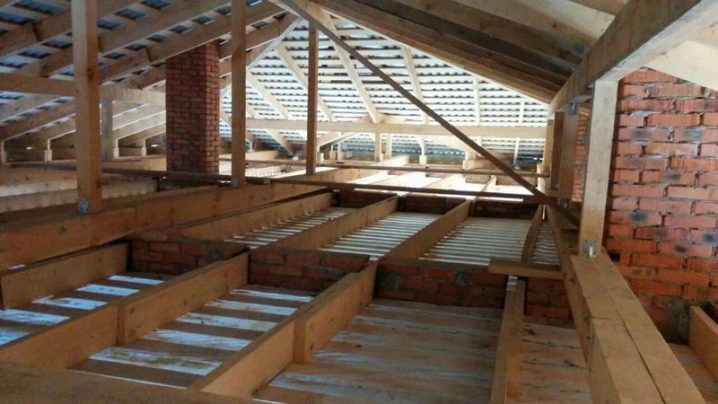
Most private houses are equipped with wooden beams. This is a fairly durable material, in addition, it has a democratic price. However, an attic with wood beams can only be made when the width and length of the house are no more than 10 meters, since longer lumber is not produced anywhere.
A metal beam (I-beam) is stronger than a wooden structure - it can withstand a significant load without damage. The flip side of such advantages is the heavy weight of the structure, which does not allow its use in a wooden dwelling. Reinforced concrete beams, obtained on the basis of reinforced concrete, which has been carefully molded, are applicable only in apartment buildings.
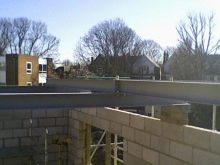
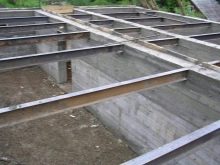
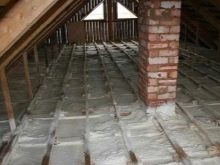
How to insulate?
The aerated concrete house is quite warm - in terms of the level of frost protection, it is three times higher than structures made of hollow ceramic bricks of comparable thickness. In this case, it is advisable to use an additional layer of waterproofing, since the probability of moisture ingress and damage to the material by it is very high. It is possible to insulate aerated concrete buildings only after 2-3 months from the date of construction.
Most often, their thermal qualities are improved using:
- Styrofoam;
- extruded polystyrene foam;
- mineral wool;
- compacted mixtures for plastering.
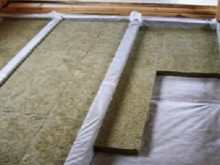

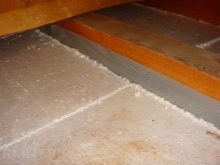
Expanded clay, vermiculite, perlite, glass wool, polyurethane foam and peat slabs can also be used for the attic floor. But whatever material is chosen, the standard technology should be strictly observed.
Sequence of work
First of all, a heat engineering calculation is carried out. Regardless of its result, it will be necessary to create an insulating layer with a thickness of 0.3 m.In those cases when, for some reason, it will be smaller, you will have to put up with insufficient heat protection. Some part of the insulation material is placed in the gaps between the beams, and about 1/3 of it is placed on top - this approach helps to avoid the appearance of cold bridges, which even the beams themselves turn out to be.
Suppose some kind of technical cotton wool is chosen. The advantages of such a product do not negate its disadvantage: a fine suspension on contact with the skin and mucous membranes, including when inhaled, provokes irritation. It is better to put slabs on top of the wooden floor, which are placed in two layers in a checkerboard pattern.

The mineral wool should be cut with scissors or a knife, the joint of the edges should be tight to avoid heat leakage. You need to put on special clothing in advance: a respirator, gloves and goggles. Waterproofing a cold attic is required if the rafter system is not protected from moisture ingress. But even if it is protected, such a measure is unlikely to be superfluous.
Installation of ceiling insulation
The installation of an insulating layer on wooden beams based on mineral wool begins with the installation of a vapor barrier. The film is placed in accordance with the technology, achieving an overlap of 10 cm. Each part protruding beyond the edge of the main block should be bent around. The points of attachment of the film to the wall require the material to be raised by at least 5 cm, and the thickness of the mineral wool is also taken into account.

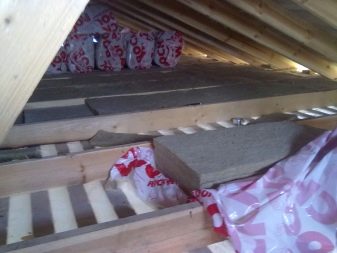
At the second stage, the turn comes to the insulation material itself. It is cut with construction knives, carefully making sure that the cotton does not squeeze and does not have cracks, since both of these factors will significantly deteriorate its quality. Cotton wool should not be lifted higher than the beams. If you have to create a very thick layer, then the main structures are built up with additional slats or a bar.On top of the insulation, another layer of vapor barrier is placed, and only then a rough finish is carried out.
Floor insulation
Many people, in order to increase the living space in the house, make the attic the second floor. In this case, the insulation of its floor has its own characteristics.
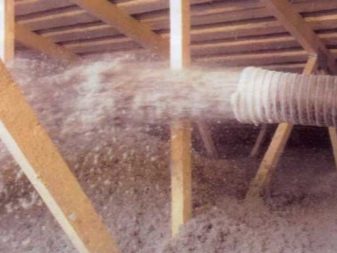
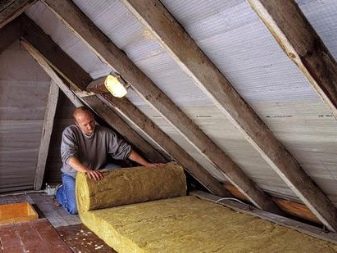
The sequence of layers in a wooden house is as follows:
- the ceiling of the first floor;
- construction paper;
- load-bearing beams made of good timber;
- mineral wool, it is placed in the cells formed by the beams themselves;
- another layer of paper;
- floor covering.
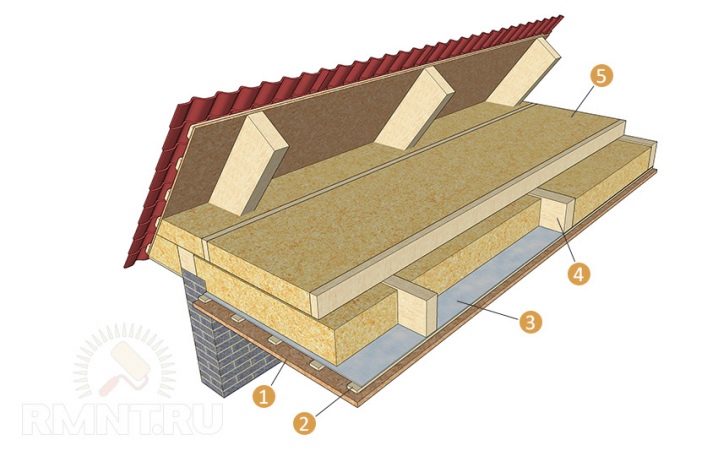
It is categorically unacceptable to deviate from this list or violate the order of items in it, as this will greatly impair the protection against heat leakage and water penetration. A couple of layers of plywood are added to the insulation in the "pie" - it helps to increase protection against loud sounds. And if, instead of mineral wool, expanded clay is used, then a concrete screed is placed over it in a dry way.
The floor should be insulated by laying the material in the cellsformed by the rafter system. Manufacturers have taken care of converting simple technical wool into slabs that are much easier and more convenient to install. In order to be able to press the slab directly into the cells, its thickness should be at least 20 cm. Professionals love this method, but amateurs are better off abandoning it, due to the excessive consumption of material. The best option is to place the slabs under the rafters and in the gaps between them; if necessary, auxiliary frame parts are made.
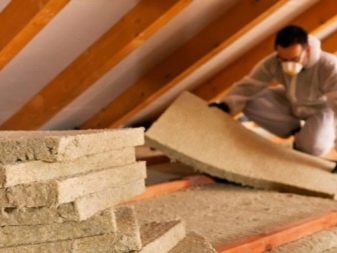
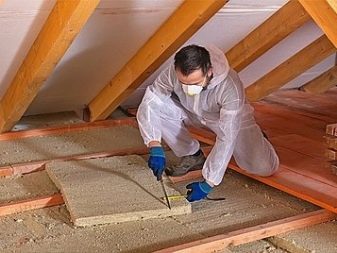
Laying panel materials only under the rafters themselves will require the creation of additional lathing, absorbing part of the attic volume. Therefore, such a decision is allowed only in cases where no other measures help at all. If the ceiling of the second floor is located under the attic, and not under the roof itself, it is necessary to increase the thermal protection of the ceiling both from below and from above.
In order for the insulation of the second floor floor to give an optimal result, you need to work not only on it. Even the walls need to be prepared: close the cracks with tow, soak them with antiseptics. Only under this condition can it be guaranteed that with any changes in the external environment, it will be warm in all parts of the house.
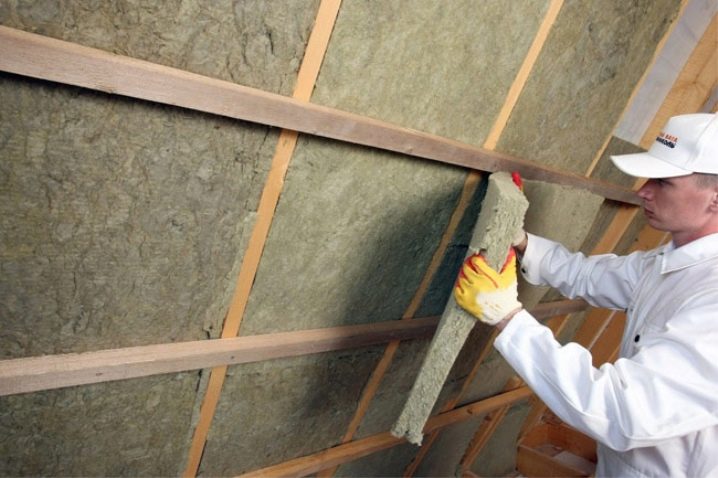
Then you will need:
- fix horizontal slats for the ventilation system;
- install a membrane that increases the protection against steam;
- install vertical posts, which will then allow the plates to be fixed;
- place insulation in the gaps of racks made of timber or aluminum profiles;
- fix the second vapor barrier layer;
- finish the surface with clapboard, plasterboard sheets, chipboard or other coating.

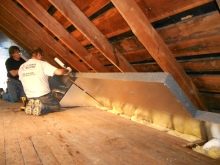
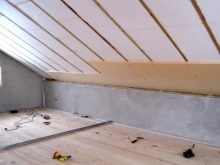
Tips & Tricks
It is possible to increase the protection of the upper part of the house from heat loss not only due to thermal insulation materials. A very important factor is the arrangement of good ventilation. The total area of the holes for it should be equal to 0.5% of the total overlap surface. It is recommended to give preference to non-combustible insulation - this is especially important in wooden houses.
It is better to refuse from polystyrene and expanded polystyrene altogether, since it easily ignites, attracts the attention of mice and insects, and the foam layer cannot be disassembled.
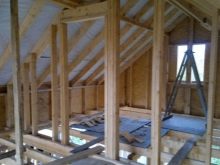
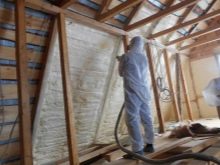
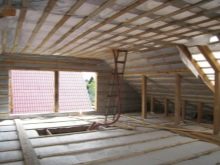
That is why even the excellent heat-shielding qualities of this material do not allow us to consider it an acceptable solution.
Additionally, you should consider:
- there should be ladders to facilitate access to different places, they are created from boards;
- all wooden parts with which the insulating material will contact must be impregnated with fungicides and hydrophobic compounds;
- using foil insulation, it must be laid with the shiny side down.
You can learn how to properly insulate the attic floor from the video below.













The comment was sent successfully.